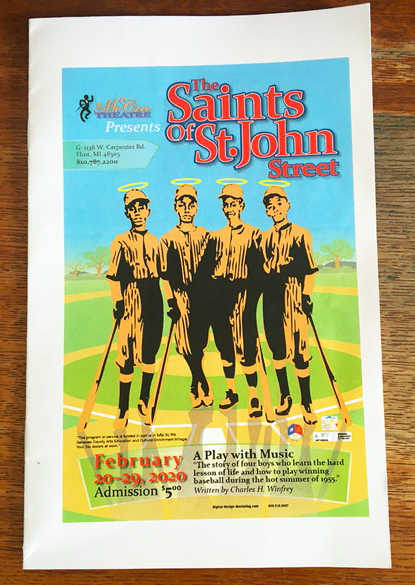By Patsy Isenberg
“The now demolished St. John Street neighborhood is historic in the sense it was one of only two areas African Americans could reside in as they migrated to Flint from the south.” That’s the first sentence about the authentic and nostalgically effective play, “The Saints of St. John Street” from the program for the Charles Winfrey memoir that opened Feb. 20 at the New McCree Theatre, 2040 W. Carpenter Rd., Flint.
Of the St. John neighborhood, the description continues, “Residents shopped there, worshipped there, and partied there. Sharing was as commonplace as the soot that rained down upon them from the Buick Foundry.”
Charles Winfrey, executive director of The New McCree Theatre, penned the play based on his own experiences growing up in one of Flint’s most historically significant neighborhoods. Studied and analyzed in numerous articles and books, such as Andrew Highsmith’s Demolition Means Progress or remembered in the paintings of noted Flint artist Lavarne Ross –the vitality of the St. John Street neighborhood is a ghost now in the shadow of its neighbor, the Buick City brownfield–where 30,000 General Motors workers once clocked in on three shifts in one of the world’s biggest manufacturing complexes.
Winfrey’s play, directed by Cathye Johnson, drew an audience of nearly 400 on opening night. The 26-member cast of all ages and genders inhabited the fictionalized characters and vividly brought Winfrey’s recollections alive, portraying day to day life the St. John neighborhood in the summer of 1955, when Winfrey was 12 years old.

Winfrey recreates several interesting plots going on in the neighborhood that summer. One of the main ones, the one that provides the title of the play, is the journey four boys in the neighborhood take to play baseball. One kind-hearted father takes on the job of coaching them and they become a team, The Saints. At first the boys don’t know how to play baseball but they are encouraged by their coach to keep trying and practice.
Another situation is when one of the young daughters goes missing and the neighbors are confronted with trying to get help from a white police officer with an attitude. The cop is dressed down by Slap-God-A-Mighty, played by Patricia Enright, who is also the theatre’s marketing director. It all feels true and believable, capturing issues in the community that echo even into Flint life today.
The set was just three buildings on the corner of St. John Street and Leith–a central locale back in the day — two houses and a pawn shop. But, like in any neighborhood, it was arranged so that there were several ways into and out of the neighborhood which kept the action moving naturally. The families spend a lot of time on their porches and interact with each other and anyone else strolling by. The families both have kids and the parents are together raising them. One family has four daughters and their next door neighbor has a son and a daughter. The fathers, mothers, and kids all have unique personalities and react to situations differently as would be the case and the play is well-written and acted to illustrate that the complexities of not just the neighborhood, but the characters living together within it.
At the beginning of the play the two fathers are on their respective porches discussing their challenges and “especially the (recent) brutal murder of (young) Emmett Till.” Popular recorded music from that era peppers the action in a natural way all through the play. That music, the costumes, their way of speaking to each other, and the plight their families experience in Flint all combine to make it feel real. There’s also a five-member acapella group, The Calvacades, who sing on the corner from time to time. David Lott, Phillip Young, Linwood Peacock, Fredrick Fife, and Clifford Sykes make up the group singing an original song, “St. John Street.” The music for that was written by by Phillip Young with lyrics by Winfrey. Also, one of the young boys, Stick, played by Isaiah Grays who lives on the street sings, “The Great Pretender” beautifully at one point.
The play continues through next weekend, Feb. 27-29. Performances are Thur. at 7 p.m., Fri. at 7 p.m, and Sat. at 2 p.m. and 7 p.m. Tickets are $5. For more information on events or to buy tickets go to thenewmccreetheatre.com. The theatre is at 2040 W. Carpenter Rd.
Banner photo of “The Saints of St. John Street” cast by Patsy Isenberg.
EVM Staff Writer Patsy Isenberg can be reached at pisenber@gmail.com. EVM Editor Jan Worth-Nelson contributed to this story. She can be reached at janworth1118@gmail.com.


You must be logged in to post a comment.